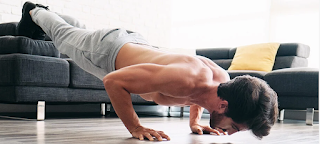Developing a Well-Rounded Bodyweight Workout Routine: Tips for All Levels
A good bodyweight workout routine can help anyone achieve their desired level of fitness without stepping into a gym. This is all about building strength, gaining flexibility, and increasing endurance using one's own body weight. The capability to learn how to create a well-rounded plan equips readers to take charge and make positive and continuous improvements in their workouts.
Bodyweight exercises can be modified to fit any fitness level, from basic to advanced. They give the freedom to exercise anywhere and, therefore, make fitness available. If properly addressed, anyone can set up their routine that allows them to stay enthusiastic and motivated.
Key Takeaways
- Bodyweight exercises build strength and flexibility using no equipment.
- A well-rounded routine considers different muscle groups and fitness levels.
- Consistency and variation are two keys to maintaining motivation for further progress.
Fundamentals of Body Weight Training
Body weight training is based on the resistance the individual provides by their body. Resistance that is built through this type of training helps improve strength, endurance, and flexibility. A little background will help in generating an effective workout schedule.
Getting to Know Your Body's Limitations and Potentials
Every individual has strengths and weaknesses. Understanding your potentials will allow for a personalized workout.
Key Factors:
- Fitness Level: Beginners should begin with basic exercises like push-ups and squats. Advanced practitioners can investigate more complicated movements.
- Mobility: Exercise performance is directly related to movement of the joints. Poor mobility can also serve as an invitation to injury.
- Core Stability: The core provides the foundation for all movements. Learning to engage the core properly during exercise maximizes both performance and safety.
One should also learn to listen to his or her body. Often pain or discomfort indicates something that needs to be changed or modified.
Housekeeping Movement Patterns
Movement patterns common to humans are integral to body weight training. Training based on the development of these patterns encourages balance in the workout.
Key Patterns Include:
- Push: Movements include push-ups, which target the chest and arms.
- Pull: The back and biceps are developed in pull-ups.
- Squat: In this movement, the legs take part, along with the glutes.
- Hinge: Exercises in hip thrust emphasize the posterior chain.
- Core Engagement: Planks and twists strengthen the core.
Variety in these movements helps one avoid any imbalances. It also encourages functional strength to flow into daily activities.
Progressive Overload and Adaptation
Good progress really depends upon the principle of progressive overload. That means one should gradually build up the intensity in the gym.
How to Achieve This:
- More Repetitions: Perform more, but from a comfortable number; work your way upwards.
- Adding Variety: Change the exercise to engage different muscles.
- Less Rest Time: Decreasing the resting periods affects workout intensity.
Adaptation refers to the changes necessary in response to greater demands. It's crucial because these changes bring improvements in strength and muscular hypertrophy. Monitoring the progress will also have a positive influence on motivation and further development.
Design of Workout Plan
There are some important steps one has to execute while preparing a workout program. Each of the steps allows one to ensure that the routine will not only be effective but also enjoyable and safe as well. The following covers clear goals, balance, exercise choice, and need for rest.
Establishing Clear Goals
Setting goals is the most critical thing you should do before beginning your workout routine. Your goals may be to lose weight, gain muscle, feel more endurance, or improve flexibility. Goals should always be specific, measurable, achievable, relevant, and time-bound.
For example, instead of "I want to get fit," this could be a SMART goal: "I want to do 20 push-ups in a row in two months." It is easier to stay motivated and measure progress when goals are clear.
Making a Balanced Routine
There are several kinds of exercises that compose a balanced workout routine. The foundation includes strength, endurance, flexibility, and mobility. Each type has a different purpose.
- Strength: Push-ups, squats, and lunges all work to build muscles.
- Endurance: Such as running or jumping jacks to promote cardiovascular exercise.
- Flexibility: Stretching or the practice of yoga promotes range.
- Mobility: It takes dynamic movements and promotes your joints' health.
The balance of the mentioned elements prevents injuries and promotes overall fitness.
Exercises Selection and Sequencing
The selection of exercises is the core of every workout program. Each exercise must relate to the predetermined goals and balancing routine.
Some exercises can be structured in some logical series or sequence for effectiveness. One generally accepted method is starting with compound movements and then moving on to isolation exercises.
The typical structure might look something like this, for example:
- Warm-up: 5-10 minutes of cardio easy
- Strength exercises: squats, push-ups, and planks
- Endurance exercises: burpees or high knees for 1-2 minutes
- Flexibility exercises: cooling down with some yoga poses or some static stretches
This form of structuring will help in maximizing the gym workout and limiting fatigue.
Rest and Recovery
Rest is often forgotten, yet it is an integral component of each exercise regimen. Rest is what the human body needs to recover and adapt itself to the load resulting from training.
You should include at least one or two rest days in your weekly schedule. Furthermore, you have to give heed to your body: if you happen to feel tired or aching, then take more days off or do light exercises only, such as walking or stretching.
Another incorporation can be that of active recovery. Activities like light yoga or swimming allow the movement to continue without placing too much stress on the body.



